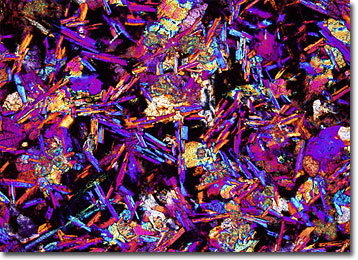Polarized Light Microscopy Digital Image Gallery
Basalt
Basalt is a fine-grained igneous rock that may exhibit hues of dark green, reddish brown, dark gray, or black. Like other igneous rocks, basalt is associated with volcanoes, forming through the solidification of a molten state.

View a second image of Basalt
Basalts may vary greatly in composition and form. Some types, for instance, are compact and display a smooth, glassy surface, while others are porous or feature large, distinct crystals in a groundmass matrix. These conspicuous crystals most commonly consist of augite, feldspars, and olivine. Basalts also typically contain about 50 percent silica, as well as a relatively large amount of iron and magnesium. Large deposits of basalt are present in numerous locations around the world, including the mid-oceanic islands, Iceland, Germany, Turkey, Australia, India, Italy, and the United States. The deposits vary in appearance as do the composition of the individual igneous rocks. For instance, in Wyoming, basalt is fashioned into the columns of rock known as the Devilís Tower, though in other locales the material may exhibit a more jagged or coil-like shape.
Interestingly, many of the moon rocks brought back to Earth by the Apollo space missions are basalts. These samples from the moon are, however, slightly different than terrestrial basalts, lacking organic compounds and water, as well as containing higher levels of certain substances, such as iron and magnesium. Nevertheless, the lunar rocks offer important evidence of the moonís history. The development of basalts, for example, is an indication that the moon formerly experienced a series of events that included massive amounts of heating and melting, despite the low level of lunar activity demonstrated today.
